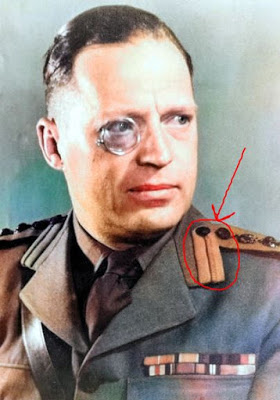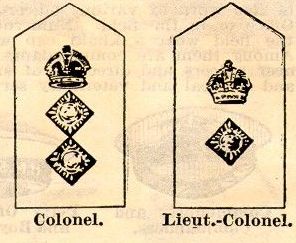If you look for Robin W.G. Stephens on the internet, you will likely come across this photo. I think it originally comes from the Imperial War Museum. Stephens, for those who may not know, was the commandant of Camp 020, MI5’s secret Second World War interrogation centre at Latchmere House (Ham Common). Stephens was a rather controversial character after the war, enduring a court martial for alleged mistreatment of prisoners at the Bad Nenndorf interrogation centre in northern Germany. Although he was acquitted of all charges, his career seemed to take a bit a sideways turn after that.

My personal interest in Stephens is the fact that he interrogated my grandfather, Josef Jakobs, at Camp 020. Parachuted into England on 31 January 1941, Josef injured his ankle leaving the aircraft and was quickly picked up by the Home Guard the next morning. Josef experienced his first interrogation with Stephens on 2 February 1941 at Camp 020. It was a short meeting and Josef broke quite quickly under Stephens’ intense questioning.
Slowly, piece by piece, I am assembling fragments of Stephens’ career. His death date and location still eludes me but I have hope that one day… it will be found. In the meantime… I had the bright idea of colorizing the photograph of Stephens, if only to see if it adds a bit of humanity to the man. I know that colorizing old black and white photographs can seem scandalous to some but… I thought I would give it a try.
My first attempt used Colorize, an Android app that allows a user to have 10 images colorized for free. The app colorizes the black and white image using an algorithm and there is no way to make any adjustments or suggestions. This is the result.

Not bad for a first start. The uniform is vaguely green. The skintone looks pretty good. Even the ribbons on the medal ribbon bar seem to be in the right colour family, albeit quite washed out. The shoulder tab is a yellow-gold colour and also seems about right. The thing that threw me was the collar tab, also known as a collar patch or gorget. Introduced in the mid 1800s, the gorgets eventually developed into a rainbow of colours to denote different branches of service. By 1940, there was:
- Bright blue – Engineers
- Dark blue – Ordnance
- Pale blue – Education
- Scarlet – General Staff Duties
- Cherry – Medical
- Maroon – Veterinary
- Purple – Chaplain
- Green – Dental
- Yellow – Accountant
After 1921, however, only staff officers of colonel rank and higher could wear the gorgets. So… the fact that Stephens has some collar tabs would suggest that he was at least a Substantative Colonel or higher, possibly a Brigadier. And his collar tabs were unlikely to have been yellow (accounting) but most likely red or scarlet (General Staff duties).
I found another colorizer, a web app, that allowed me to add some colour to specific areas and after a bit of tweaking… we have this.

Not bad, I think. The red is a tad off but the colorizer was giving me trouble so I settled for a muted red in line with the rest of the photograph. As for Stephens’ rank, judging by the shoulder pips, which are, admittedly, a challenge to decipher on the photograph, I think it’s save to say that we have two stars and a crown.

On his right shoulder (our left), it looks to me like two stars at the left (almost identical profiles) followed by the larger star and then the fastener for the collar tab. I suspect the fastener for the shoulder tab is hidden behind the collar tab fastener.


On his left shoulder (our right), we can clearly see the two fasteners on the left for the collar tab and the shoulder tab. We are then left with a crown (second from the right) and a star, with likely another star out of image.
From all of this, we can conclude that, when the photograph was taken, Stephens was a colonel. I had thought he might be a brigadier but that require three stars arranged in a pyramid shape below the star. And I don’t think that’s what we see on this image.
[N.B. Some blog readers have suggested that the rank is just a Lt. Colonel. It doesn’t seem completely clear to me. Stephens’ right shoulder would seem to have two stars and a crown while the left should would be a star and one crown. I think there is a second crown out of view. I have a couple more blogs coming out on Stephens in the next couple of weeks – perhaps they will help with the rank.]
I’ve also received a couple of comments from blog readers who have suggested that the rank insignia on his shoulders are black (the colorizer tended to try to brighten them up) which would be consistent with him having been in a rifle regiment (from his time in India). Clearly he liked to maintain a connection with his past regiments.
In my next blog, I’m going to take a closer at the medal ribbon bar in this photograph. I think I count eight medal ribbons and yet Chris Bilham’s article from Medal News (2014) only listed seven medals…

Hello.
Very interesting blog. Your sleuthing on Col. Stephens makes excellent reading.
This article may provide some interesting background:
THE ORIGIN AND DEVELOPMENT OF THE GORGET PATCH
N. P. Dawnay
Journal of the Society for Army Historical Research
Vol. 24, No. 98 (Summer, 1946), pp. 74-82 (13 pages)
Published By: Society for Army Historical Research
https://www.jstor.org/stable/44220042
Thanks for the tip!